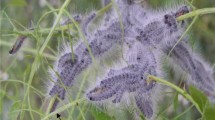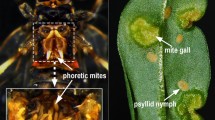Abstract
We investigated plant-mediated effects of the stem gall wasp, Dryocosmus kuriphilus Yasumatsu (Hymenoptera: Cynipidae), on other herbivores on the chestnut tree Castanea crenata. In the early season, leaves emerged earlier and in greater numbers on galled shoots than on ungalled shoots. On galled shoots the leaf to shoot biomass ratio was lower and the leaves were physically different. In May and June the concentration of nitrogen in leaves was higher on galled shoots than on ungalled shoots. In July, the water content of leaves was lower on galled shoots. In May and June, the number of aphids, Myzocallis kuricola Matsumura (Homoptera: Aphidoidea), on leaves was higher on galled shoots than on ungalled shoots, but the opposite was true at the end of July. Laboratory experiments showed that aphid fecundity and body weight decrease were higher in May and June when aphids fed on leaves on a galled shoot than when they fed on those on ungalled shoots. In contrast, aphid performance in July was greater on ungalled leaves than on galled leaves. Our findings suggest that gall initiation in a chestnut tree affected aphid performance by affecting host plant quality.





Similar content being viewed by others
References
Abrahamson WG, Weis AE (1997) Evolutionary ecology across three trophic levels: goldenrods, gallmakers, and natural enemies. Princeton University Press, United Kingdom
Ackerly DD, Bazzaz FA (1995) Leaf dynamics, self–shading and carbon gain in seedlings of a tropical pioneer tree. Oecologia 101:289–298. doi:10.1007/BF00328814
Addicott FT (1968) Environment factors in the physiology of abscission. Plant Physiol 43(9):1471–1479
Allison SD, Schultz JC (2005) Biochemical responses of chestnut oak to a galling cynipid. J Chem Ecol 31:151–166. doi:10.1007/s10886-005-0981-5
Awmack CS, Leather SR (2002) Host plant quality and fecundity in herbivores insects. Annu Rev Entomol 47:817–844. doi:10.1146/annurev.ento.47.091201.145300
Bailey JK, Whitham TG (2002) Interactions among fire, aspen, and elk affect insect diversity: reversal of a community response. Ecology 83:1701–1712. doi:10.2307/3071989
Bosio G, Gerbaudo C, Piazza E (2009) Dryocosmus kuriphilus Yasumatsu: an outline 7 years after the first report in Piedmont (Italy). In: Moriya S (Ed) A global series pest of chesntut trees, Dryocosmus kuriphilus: yesterday, today and tomorrow. Proceeding of Japan-Italy joint international symposium. National Agriculture Research Center, pp 3–15
Brenes-Arguedas T, Horton MW, Coley PD, Lokvam J, Waddell RA, Meizoso-O’Meara BE, Kursar TA (2006) Contrasting mechanisms of secondary metabolite accumulation during leaf development in two tropical in two tropical tree species with different leaf expansion strategies. Oecologia 149:91–100. doi:10.1007/s00442-006-0423-2
Chase JM, Leibold M, Simms E (2000) Plant tolerance and resistance in food webs: community-level predictions and evolutionary implications. Evol Ecol 14:289–314. doi:10.1023/A:1010983611618
Cooper WR, Rieske LK (2007) Community associates of an exotic gallmaker, Dryocosmus kuriphilus (Hymenoptera: Cynipidae), in Eastern North America. Ann Entomol Soc Am 100(2):236–244. doi:10.1603/0013-8746(2007)100[236:CAOAEG]2.0.CO;2
Cooper WR, Rieske LK (2009) Woody stem galls interact with foliage to affect community associations. Environ Ecol 38(2):417–424. doi:10.1603/022.038.0215
Cooper WR, Rieske LK (2011) Chestnut species and jasmonic acid treatment influence development and community interactions of galls produced by the Asian chestnut gall wasp, Dryocosmus kuriphilus. J Insect Sci 11:Article 40. doi:10.1673/031.011.14001
Denno RF, Kaplan I (2007) Plant mediated interactions in herbivorous insects: mechanisms, symmetry, and challenging the paradigms of competition past. In: Ohgushi T, Craig TP, Price PW (eds) Ecological communities: Plant mediation in indirect interaction Webs. Cambridge University Press, Cambridge, pp 19–50
Denno RF, Peterson MA, Gratton C, Cheng J, Langellotto GA, Huberty AF, Finke DL (2000) Feeding-induced changes in plant quality mediate interspecific competition between sap-feeding herbivores. Ecology 81(7):1814–1827. doi:10.1890/0012-9658(2000)081[1814:FICIPQ]2.0.CO;2
Dixon AFG (2005) Insect herbivore—host dynamics. Cambridge University Press, United Kingdom
Dixon WN, Burns RE, Stange LA (1986) Oriental chestnut gall wasp Dryocosmus kuriphilus Yasumatsu (Hymenoptera: Cynipidae). Entomology Circular No. 287. Florida Department of Agriculture & Consumer Services, Division of Plant Industry
Dorchin N, Cramer MD, Hoffmann JH (2006) Photosynthesis and sink activity of wasp-induced galls in Acacia pycnantha. Ecology 87(7):1781–1791. doi:10.1890/0012-9658(2006)87[1781:PASAOW]2.0.CO;2
Fay PA, Throop HL (2005) Branching responses in Silphium integrifolium (asteraceae) following mechanical or gall damage to apical meristems and neighbour removal. Am J Bot 92(6):954–959. doi:10.3732/ajb.92.6.954
Fay PA, Hartnett DC, Knapp AK (1996) Plant tolerance of gall insect attack and gall performance. Ecology 77(2):521–534. doi:10.2307/2265627
Forcat S, Bennet MH, Mansfield JW, Grant MR (2008) A rapid and robust method for simultaneously measuring changes in the phytohormones ABA, JA and SA in plants following biotic and abiotic stress. Plant Methods 4:16. doi:10.1186/1746-4811-4-16
Foss LK, Rieske LK (2004) Stem galls affect oak foliage with potential consequences for herbivory. Ecol Entomol 29:273–280. doi:10.1111/j.1365-2311.2004.00595.x
Goggin FL (2007) Plant–aphid interactions: molecular and ecological perspectives. Curr Opin Plant Biol 10:399–408. doi:10.1016/j.pbi.2007.06.004
Hartley SE, Lawton JH (1992) Host-plant manipulation by gall-insects: a test of the nutrition hypothesis. J Anim Ecol 61:113–119. doi:10.2307/5514
Haukioja E, Koricheva J (2000) Tolerance to herbivory in woody vs. herbaceous plants. Evol Ecol 14:551–562. doi:10.1023/A:1011091606022
Huberty AF, Denno RE (2004) Plant water stress and its consequences for herbivorous insects: a new synthesis. Ecology 85(5):1383–1398. doi:10.1890/03-0352
Inbar M, Eshel A, Wool D (1995) Interspecific competition among phloem-feeding insects mediated by induced host-plant sinks. Ecology 76(5):1506–1515. doi:10.2307/1938152
Inbar M, Doostdar H, Mayer RT (2001) Suitability of stressed and vigorous plants to various insect herbivores. Oikos 94:228–235. doi:10.1034/j.1600-0706.2001.940203.x
Ito Y, Nakamura M, Kondo M, Miyashita K, Nakamura K (1962) Population dynamics of the chestnut gall-wasp, Dyocosmus kuriphilus Yasumatsu (Hymenoptera: Cynipidae) II. Distribution of individuals in bud of chestnut tree. Res Popul Ecol 4(1):35–46
Izzo TJ, Juliao GR, Almada ED, Fernandes GW (2006) Hiding from defenders: localized chemical modification on the leaves of an Amazonian ant-plant induced by a gall-making insect (Diptera: Cecidomyiidae). Sociobiology 48:417–426
Karban R, Baldwin IT (1997) Induced responses to herbivory. The University of Chicago press, Chicago
Karban R, Myers JH (1989) Induced plant responses to herbivory. Annu Rev Ecol Syst 20:331–348. doi:10.1146/annurev.es.20.110189.001555
Kato K, Hijii N (1997) Effects of gall formation by Drycosmus kuriphilus Yasumatsu (Hym., Cynipidae) on the growth of chestnut trees. J Appl Entomol 121:9–15. doi:10.1111/j.1439-0418.1997.tb01363.x
Kato K, Hijii N (1999) Mortality factors of the chestnut gall-wasp, Dryocosmus kuriphilus Yasumatsu (Hymenoptera: Cynipidae) after gall formation. Entomol Sci 2(4):483–491
Kato K, Hijii N (2001) Ovipositional traits of the chestnut gall wasp, Dryocosmus kuriphilus (Hymenoptera: Cynipidae). Entomol Sci 4:295–299
Khattab H, Khattab I (2009) Responses of Eucalypt trees to the insect feeding (Gall-Forming Psyllid). Int J Agric Biol 7(6):979–984
Liu Z, Cai Y, Fang Y, Jing J, Li K (2010) Induced response in Schima superba: effects of early season herbivory on leaf traits and subsequent insect attack. Afr J Biotechnol 9(51):8731–8738. doi:10.5897/AJB10.1380
Nakamura M, Ohgushi T (2003) Positive and negative effects of leaf shelters on herbivorous insects: linking multiple herbivore species on a willow. Oecologia 136:445–449. doi:10.1007/s00442-003-1285-5
Nakamura M, Miyamoto Y, Ohgushi T (2003) Gall initiation enhances the availability of food resources for herbivorous insects. Funct Ecol 17:851–857. doi:10.1111/j.1365-2435.2003.00786.x
Ohgushi T (2005) Indirect interaction webs: herbivore-induced effects through trait change in plants. Annu Rev Ecol Evol Syst 36:81–105. doi:10.1146/annurev.ecolsys.36.091704.175523
Ohgushi T, Craig TP, Price PW (2007) Ecological communities: Plant mediation in indirect interaction webs. Cambridge University Press
Orcutt DM, Nilsen ET (2000) The physiology of plants under stress: soil and biotic factors. Wile, New York
Otake A (1980) Chestnut gall wasp, Dryocosmus kuriphilus Yasumatsu (Hymenoptera: Cynipidae): a preliminary study on trend of adult emergence and some other ecological aspects related to the final stage of its lifecycle. Appl Entomol Zool 15:829–839
Pegadaraju V, Knepper C, Reese J, Shahet J (2005) Premature leaf senescence modulated by the Arabidopsis phytoalexin deficient4 Gene is associated with defense against the phloem-feeding Green Peach Aphid. Plant Physiol 139:1927–1934. doi:10.1104/pp.105.070433
Price PW (1991) The plant vigor hypothesis and herbivore attack. Oikos 62:244–251. doi:10.2307/3545270
Quacchia A, Moriya S, Bosio G, Scapin I, Alma A (2008) Rearing, release and settlement prospect in Italy of Torymus sinensis, the biological control agent of the chestnut gall wasp Dryocosmus kuriphilus. BioControl 53:829ol 53. doi:10.1007/s10526-007-9139-4
Sabatier S, Barthelemy D (2000) Bud structure in relation to shoot morphology and position on the vegetative annual shoots of Juglans regia L. (Juglandaceae). Ann Bot 87:117–123. doi:10.1006/anbo.2000.1312
Shorthouse JD, Rohfritsch O (1992) Biology of insect-induced galls. Oxford University Press, New York
Stone GN, Schonrogge K (2003) The adaptive significance of insect gall morphology. Trends Ecol Evol 18(10):515–522. doi:10.1016/S0169-5347(03)00247-7
Strauss SY (1987) Direct and indirect effects of host-plant fertilization on an insect community. Ecology (68)6:1670–1678. doi:10.2307/1939859
Thaler JS, Stout MJ, Karban R, Duffey SS (2001) Jasmonate-mediated induced plant resistance affects a community of herbivores. Ecol Entomol 26:312–324. doi:10.1046/j.1365-2311.2001.00324.x
Tooker JF, Rohr JS, Abrahamson WG, De Moraes CM (2008) Gall insects can avoid and alter indirect plant defenses. New Phytol 178:657–671. doi:10.1111/j.1469-8137.2008.02392.x
Tscharnke T (1989) Changes in shoot growth of Phragmites australis caused by the gall maker Giraudiella inclusa (Diptera: Cecidomyiidae). Oikos 54:370–377. doi:10.2307/3565298
Utsumi S, Ohgushi T (2009) Community-wide impacts of herbivore-induced plant regrowth on arthropods in a multi-willow species system. Oikos 118:1805–1815. doi:10.1111/j.1600-0706.2009.17580.x
Utsumi S, Nakamura M, Ohgushi T (2009) Community consequences of herbivore-induced bottom-up trophic cascades: the importance of resource heterogeneity. J Anim Ecol 78:953–963. doi:10.1111/j.1365-2656.2009.01570.x
Van Zandt PA, Agrawal AA (2004) Community-wide impacts of herbivore-induced plant responses in milkweed (Asclepias syriaca). Ecology 85:2616–2629. doi:10.1890/03-0622
Viswanathan DV, Anita JT. Narwani, Jennifer S, Thaler (2005) Specificity in induced plant responses shapes patterns of herbivore occurrence on Solanum dulcamara. Ecology 86:886–896. doi:10.1890/04-0313
Vollenweider P, Goerg MSG (2006) Erratum to ‘‘Diagnosis of abiotic and biotic stress factors using the visible symptoms in foliage’’. Environ Pollut 140:562–571. doi:10.1016/j.envpol.2005.01.032,10.1016/j.envpol.2006.01.001
Vollenweider P, Ottiger M, Goerg MSG (2003) Validation of leaf ozone symptoms in natural vegetation using microscopical methods. Environ Pollut 124:101–118. doi:10.1016/S0269-7491(02)00412-8
Weis AE, Walton R, Crego CL (1988) Reactive plant tissue sites and the population biology of gall makers. Annu Rev Entomol 33:467–486. doi:10.1146/annurev.en.33.010188.002343
White TCR (1969) An index to measure weather-induced stress of trees associated with outbreaks of Psyllids in Australia. Ecology 50(5):905–909
White TCR (1984) The abundance of invertebrate herbivores in relation to the availability of nitrogen in stressed food plants. Oecologia 63:90–105
Williams AG, Whitham TG (1986) Premature leaf abscission: an induced plant defense against gall aphids. Ecology 67(6):1619–1627
Xiang H, Chen J (2004) Interspecific variation of plant traits associated with resistance to herbivory among four species of Ficus (Moraceae). Ann Bot 94:377–384. doi:10.1093/aob/mch153
Acknowledgments
We thank Professor Edward Evans (Utah State University) for helpful comments and for improving the English. We also thank two anonymous reviewers for their valuable suggestions.
Author information
Authors and Affiliations
Corresponding author
Rights and permissions
About this article
Cite this article
Triyogo, A., Yasuda, H. Effect of host-plant manipulation by a gall-inducing insect on abundance of herbivores on chestnut trees. Appl Entomol Zool 48, 345–353 (2013). https://doi.org/10.1007/s13355-013-0194-2
Received:
Accepted:
Published:
Issue Date:
DOI: https://doi.org/10.1007/s13355-013-0194-2




